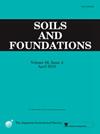路堤坝的地震反应:剪力梁分析与现场观测
IF 3.3
2区 工程技术
Q2 ENGINEERING, GEOLOGICAL
引用次数: 0
摘要
堤防大坝是基础设施的重要组成部分,它将基础、核心、壳、过滤器和溢洪道等各种组成部分集成为一个系统。为了分析它们的整个响应,重要的是要根据观察正确地识别整个系统的动态特性。考虑剪切模量和截面积随高度的变化,采用剪力梁解析法研究了平面应变条件下大坝的动力响应。首先利用贝塞尔函数解析求解控制微分方程,推导出不同自然模态下的动力响应参数。然后导出了基岩到波峰的传递函数,用于不同剪切模量和材料阻尼水平的变化。利用这些分析结果,该研究评估了剪切梁分析对日本23个堤防大坝的适用性,利用数十年记录的加速度时程来识别它们的动力响应和剪切波随高度的分布。本文章由计算机程序翻译,如有差异,请以英文原文为准。
Seismic response of embankment dams: Shear beam analysis vs field observations
Embankment dams are critical elements of infrastructure and perform as a system by integrating various components such as foundation, core, shell, filter and spillway. To analyze their entire response, it is important to properly identify the dynamic characteristics of the overall system based on observations. This paper explores the dynamic response of dams using an analytical shear beam analysis under plane-strain conditions, considering the variation of shear modulus and cross-sectional area with height. The governing differential equation is first solved analytically using Bessel functions, and dynamic response parameters are derived for different natural modes. Transfer functions are then derived from the bedrock to the crest for different variations of shear modulus and levels of material damping. Using these analytical results, the study assesses the applicability of the shear beam analysis to 23 embankment dams in Japan, utilizing decades of recorded acceleration time histories to identify their dynamic response and shear wave profiles with height.
求助全文
通过发布文献求助,成功后即可免费获取论文全文。
去求助
来源期刊

Soils and Foundations
工程技术-地球科学综合
CiteScore
6.40
自引率
8.10%
发文量
99
审稿时长
5 months
期刊介绍:
Soils and Foundations is one of the leading journals in the field of soil mechanics and geotechnical engineering. It is the official journal of the Japanese Geotechnical Society (JGS)., The journal publishes a variety of original research paper, technical reports, technical notes, as well as the state-of-the-art reports upon invitation by the Editor, in the fields of soil and rock mechanics, geotechnical engineering, and environmental geotechnics. Since the publication of Volume 1, No.1 issue in June 1960, Soils and Foundations will celebrate the 60th anniversary in the year of 2020.
Soils and Foundations welcomes theoretical as well as practical work associated with the aforementioned field(s). Case studies that describe the original and interdisciplinary work applicable to geotechnical engineering are particularly encouraged. Discussions to each of the published articles are also welcomed in order to provide an avenue in which opinions of peers may be fed back or exchanged. In providing latest expertise on a specific topic, one issue out of six per year on average was allocated to include selected papers from the International Symposia which were held in Japan as well as overseas.
 求助内容:
求助内容: 应助结果提醒方式:
应助结果提醒方式:


